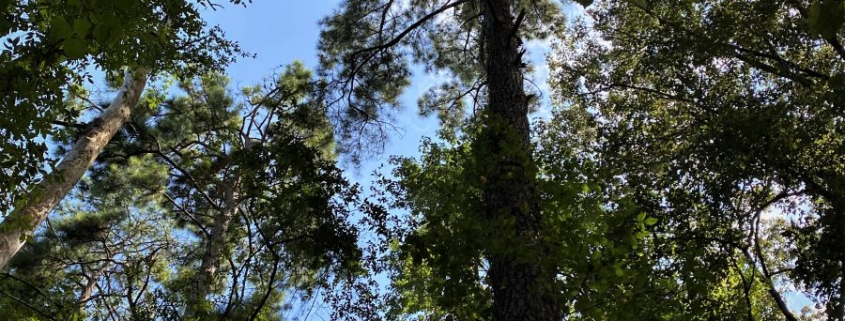Pine Forest on a Rich Terrace above Lake Wheeler on the WNW Refuge
We’re now into the second week of September. Continuing to enjoy our early morning walks, Judy and I are aware that dawn now breaks as we complete our circuit. And we’ve noticed near silence from our avian friends who chattered and clamored in greeting spring and early summer dawns. I’m reminded of Aldo Leopold’s observation in A Sand County Almanac:
By September, the day breaks with little help from birds. A song sparrow may give a half-hearted song, a woodcock may twitter overhead en route to his daytime thicket, a barred owl may terminate the night’s argument with one last wavering call, but few other birds have any thing to say or sing about.
From my September vantage point I’m drifting back to August 18, 2020, when Alabama State Parks Naturalist Emeritus Mike Ezell and I visited the eastern end of Wheeler National Wildlife Refuge. I had previously posted a photo-essay from my August 1, 2020, bushwhacking through a nearby riparian hardwood forest: https://stevejonesgbh.com/2020/08/19/august-riparian-forest-roaming-at-the-wheeler-national-wildlife-refuge/ And just last week I posted an essay from my August 8, 2020 ramblings in a nearby aging hardwood bottomland forest: https://stevejonesgbh.com/2020/09/01/an-aging-tennessee-river-riparian-forest/
Those reflections led Mike and me mid-month to explore a stand of towering loblolly pine (Pinus taeda) on a terrace along Wheeler Lake. While there, we also examined adjacent hardwood lowlands and investigated the rich floral displays along Blackwell Run Road, the gravel route that took us all the way around Blackwell Swamp. I focus this Post on the pine terrace. Watch for two subsequent Posts offering observations from the hardwood bottoms and then the linear botanical garden along the gravel road.
Standing Tall
I bicycled the gravel road loop around Blackwell Swamp last winter. I admired the magnificent pine forest along the route just north of the Wheeler Dam-impounded Tennessee River, vowing to return on foot at some future date. I found the opportunity to do just that some eight months later. My entry into the stand proved well worth the wait. I’m committed now to visit again this coming winter…to enjoy cooler temperatures, no biting insects (i.e. mosquitoes and chiggers), wandering free of spider webs hung at face level, views unencumbered by those pesky hardwood leaves. I’ve learned that mid-summer is not the favored forest bushwhacking season!
I’ve written so many of these Posts that from time to time I have little choice but to repeat prior observations, reflections, lessons, and stories of inspiration. Loblolly pine (Pinus taeda) is the principal pine here in northern Alabama. Loblolly is an early successional species, flourishing in full sunlight, responsive to catastrophic forest disturbance (filling in after hurricane, tornado, and fire), and quick to reclaim abandoned agricultural land. The terrace that supports the subject pine stand runs roughly east-west parallel to the river. It is bordered to the north by a bottomland hardwood forest reaching into the actual Blackwell Swamp. The terrace width varies along its quarter-mile length from 200 to 500 feet. The gravel road along the river perches on a natural levee above the now-impounded river.
Picture this terrace prior to the 1930’s completion of Wheeler Dam as cultivated with crops of corn and cotton. Pine and hardwood would have populated the immediate river bank. These pine and perhaps individuals at field-edge bordering the bottomland provided the seed source to reforest the field when the Corps of Engineers completed buffer land purchase and terminated farming. The US Forest Service silvics manual observes this about loblolly seed production and distribution:
Seedfall usually begins in October, and the bulk of the seeds are released in November and early December. Seedfall is hastened by dry, warm, windy weather and retarded by cool, wet weather. Seed dispersal in or adjacent to a stand varies with height and stocking level of the seed-source trees, magnitude of the seed crop, terrain, and weather conditions at the time of seedfall. The effective seeding distance ranges from 61 to 91 m (200 to 300 ft) in a downwind direction from the seed source and 23 to 30 m (75 to 100 ft) in other directions.
The pine trees adjacent to the terrace would have been tall, wide-crowned, and vigorous…attributes suggesting abundant seed production and height sufficient to accommodate full dispersion coverage of the terrace. The abandoned field would have provided a perfect seedbed, free of competing woody vegetation. Lush herbaceous vegetation would have also immediately invaded the field, but loblolly has long ago mastered the art and science of competing with such short-lived competitors. Loblolly quickly owned the field, drawing deeply from its fertile depths, and reaching rapidly skyward. Because loblolly does not tolerate seasonal flooding, its seedlings did not flourish on the bordering bottomland soils. The tree below is 24 inches in diameter (4.5 feet above ground level). We estimated its height at 110-120 feet. Its age at roughly 85-90 years. Height at a specified age (the base age) is the surest measure of site quality. When I practiced forestry in central and south Alabama (early 1980s), we used base age 25 years. During my forestry undergraduate days in the northeast we used base age 50 for hardwoods.
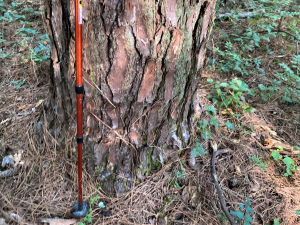
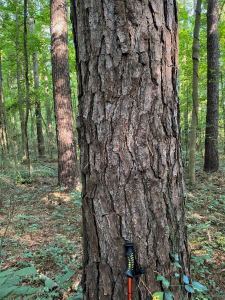
Loblolly pine matures more rapidly than northern hardwoods. Its rate of height growth lessens over time. By age 50 the slope of increase slackens toward plateauing. The dominant trees we examined are by now becoming flat-topped, failing to extend further. Although I have scant empirical evidence to support my conclusion, I estimate site quality (base age 25) for this naturally generated stand at 65-75 feet. Were this a planted stand of genetically-improved (through selective cross-breeding, provenance studies, and evaluative culling) stock, I believe this site could produce 80-foot trees by age 25.
This pine at the bottomland edge measured 30 inches in diameter, reaching high above us, dominating the adjacent trees.
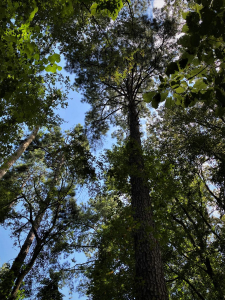
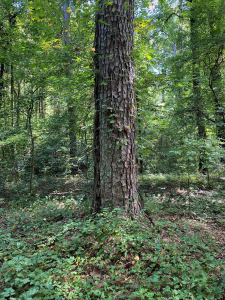
My doctoral dissertation evaluated soil-site factors for Allegheny Hardwood forests of SW NY and NW PA. I spent many days excavating soil pits, describing soil characteristics, and collecting soil samples by horizon for laboratory analyses. I was able to predict site quality on the basis of soil and site factors even without trees present to measure.
The Essence of a Rich Site
I carried my trusty sharpshooter spade (yes the very same one I used for my 1985 PhD field sampling!) into the pine stand. Compared to my very stony NY and PA sites, the terrace soil was heavenly. I scraped aside the forest litter layer. The spade slipped easily into the soil…nary a rock encountered. Yes, a root or two, but I had carefully avoided major roots.
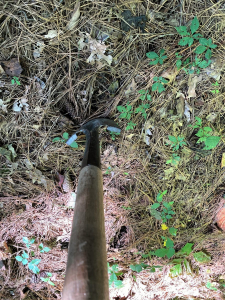
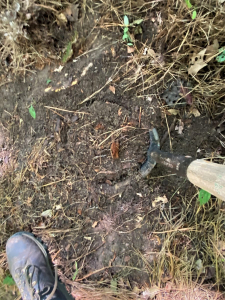
I have never lost my learned knowledge of determining soil texture (an approximation of percent content by sand, silt, and clay particles) by feel, a measure serving as a surrogate for moisture- and nutrient-holding capacity. I judged the soil to be sandy loam. We detected the old plow line (6-8 inches below the surface) still evident some nine decades after abandonment. Funny how being on my knees, connecting viscerally to the essence of the vitality, fertility, and heart of the site thrilled me to my forester’s core. I wondered how any Nature enthusiast could traipse through our magnificent forests never having looked beneath the litter layer. I know a man who cherishes old cars with souped up engines. He could not imagine appreciating the car without peering intently under the hood. Below left I am under the hood, admiring the power and strength of the thing…the soil…that ultimately sustains all terrestrial life on Earth.
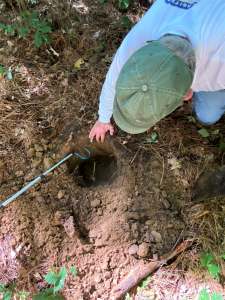
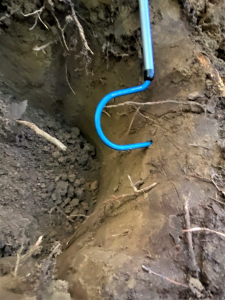
To most lay readers I stake professional claim to being a lifelong Nature enthusiast…a naturalist. Yet, given my recent re-acquaintance with my sharpshooter, I admit to still being a soil scientist. I relish getting my hands dirty. That is, the dirt of life — soil, the essence of life! There is nothing unclean about soil.
Vines in the Pine Forest
We found this hefty poison ivy vine co-living with a two-foot diameter loblolly. Some would see this and assume that the vine climbed the 110 feet into the pine crown. Such is not the case. Within a couple of years of the pine seedling taking root, a bird, having recently gorged on ripe poison ivy seed, deposited the undigested (but chemically scarified) seed from its perch atop the seedling. The vine seed sprouted the following spring, found the site fertile and suitable, and began climbing with the ascending pine. The vine kept pace, always staying in the upper reaches of the pine crown, enjoying its free ride and the full canopy-top sunlight. Theirs is a partnership. It’s clear to me what the vine takes from this joint venture. I have not surmised what’s in it for the pine. A wild guess. Perhaps pine trees with ivy entangled are less susceptible to pine bark beetle infestation. Maybe birds that reduce bark beetle numbers are more common within the ivy-draped canopy. I shall continue to search for definitive answers. I have quoted Leonardo da Vinci often, including this applicable gem:
Human subtlety will never devise an invention more beautiful, more simple or more direct than does nature because in her inventions nothing is lacking, and nothing is superfluous.
The vine and tree partnership, sustained over eons, I am sure is not without beauty, simplicity, and purpose. Ah, I love Nature’s revelations and mysteries. Every day in her wildness I find many more questions than I will ever answer.

We found aerial roots cascading from a muscadine vine. I have discussed their form and function in prior Posts. The literature on Vitus is less than helpful describing function. I’ve offered that they serve as emergency backup should some force of Nature drop the tree (and its accompanying vine) to the ground, these adventitious roots stand ready to vegetatively propagate the vine, whether the tree is dropped in-place or carried miles downstream by rampaging floodwaters. I wonder, too, whether the air roots draw moisture from high humidity air or from morning fog common along the river. Another mystery I shall be content to mull.
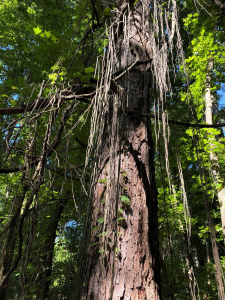
The loblolly below died in place, holding its grapevine aloft until the weakening pine stem yielded to gravity, bringing the vine with it. Interestingly, the vine had also died, falling leafless to the ground. I saw no evidence of a long ago fatal lightning strike, yet that is my assumption. Why else would both tree and vine be simultaneously dead? The level of decay leads me to conclude that the lightning ended both lives 7-10 years prior.
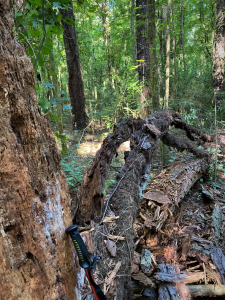
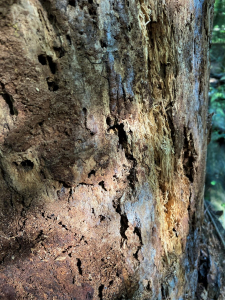
Muscadine and poison ivy vines are complemented here by supplejack (Berchemia scandens), the smooth-barked green vine below, intertwined with a larger muscadine. Both keep intimate company with the loblolly, sharing more direct sunlight high in the canopy. From iNaturalist online, The Rattan vine or Alabama supplejack is a species of climbing plant in the buckthorn family Rhamnaceae. It is native to the central and southern parts of the United States. I appreciate it for its soft green color, a sharp contrast to either poison ivy or grape.
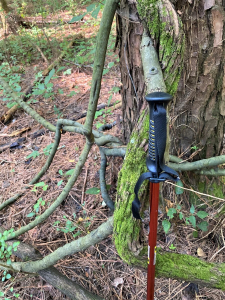
Near the road, fortified by sunlight leaking into the understory, this muscadine supported leaves and fruit within our reach. Wildlife benefits immeasurably from the rich diversity of edible fruits and seeds, as well as forage and cover, within this wonderful riparian and terrace forest ecosystem.
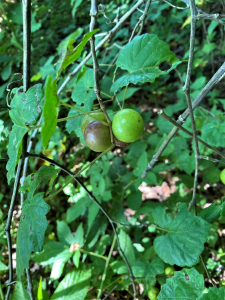
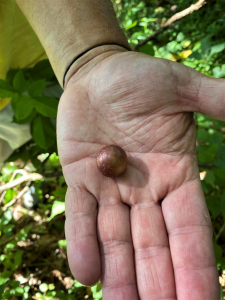
I also like supplejack for its apt moniker. It appears especially supple…twisting, twining, and assuming intricate shapes and designs, leaving its indelible signature on all woody stems that it binds and grasps.
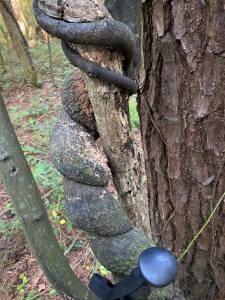
I’ll bring this Post to closure with a final set of observations, evidencing intentional forest management, in this instance a forest protection treatment.
Signs of Forest Protection Measures
For the most part, this 80-90-year-old pine terrace forest would strike the casual, lay observer as an untouched ancient forest, unmanaged and all natural. Yet, Mike and I discovered very real evidence of human intervention occurring since stand origin. We noticed a cut stump, standing 12-18″ above ground level. Then we noted three others in a rough semi-circular pattern. All four had been felled inward toward the center of the subscribed arc. They had obviously not been cut to remove commercially; the trunks (clear and straight) still lay where the sawyer felled them, some ten years earlier. Below are the first two of the four. All are well decayed.
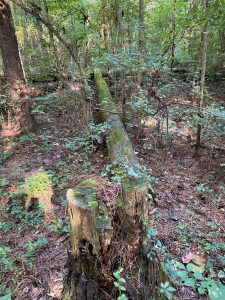

Likewise with the remaining two. Look down the stem to see where all four intersect in a jumble.
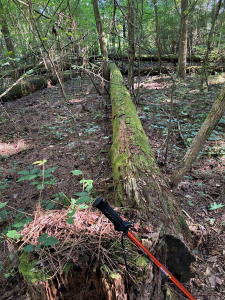
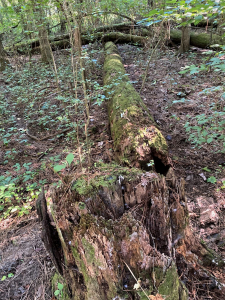
And a closer view of the jumble reveals that when felled the live crowns stacked together. For what purpose were these four felled, with crowns overlapping on the ground? Imagine a southern pine beetle outbreak a decade or so ago. I recall outbreaks during my forest products industry days. At the first indication of pine beetle epidemics (they occur every 8-12 years across the south), we would map (by road and aircraft) pockets of infestation, and systematically harvest the infested trees and a buffer.
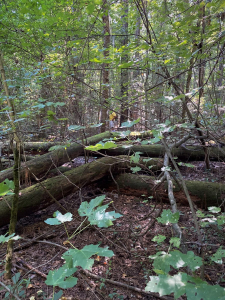
Here is what the University of Florida Institute of Food and Agricultural Sciences (IFAS) offers:
The southern pine beetle (SPB; Dendroctonus frontalis), is the most destructive insect pest of pine in the southern United States. A recent historical review estimated that SPB caused $900 million of damage to pine forests from 1960 through 1990. This aggressive tree killer is a native insect that lives predominantly in the inner bark of pine trees. Trees attacked by SPB often exhibit hundreds of resin masses (i.e., pitch tubes) on the outer tree bark. SPB feed on phloem tissue where they construct winding S-shaped or serpentine galleries. The galleries created by both the adult beetles and their offspring can effectively girdle a tree, causing its death. SPB also carry, and introduce into trees, blue-stain fungi. These fungi colonize xylem tissue and block water flow within the tree, also causing tree mortality. Consequently, once SPB have successfully colonized a tree, the tree cannot survive, regardless of control measures.
Most IFAS-recommended treatment measures involve cutting and removing the infested trees. However, IFAS offers a final option that I believe is precisely what the Refuge managers performed at this spot infestation:
Where tree removal is not feasible, infested stems can be felled, bucked and hand-sprayed with an approved insecticide. Where none of the above approaches is feasible, infested trees, with or without a buffer strip, may be simply felled toward the center of the spot. This cut-and-leave approach has had limited use with variable results.
In this case, with four infested trees, the treatment either worked or took place coincident with the natural end of infestation. We could offer no other explanation for our four felled mystery trees in the heart of this lovely river terrace pine forest. We both relished our efforts as forensic naturalists. I’ll repeat my mantra that every wild place has at least one story to tell, oftentimes at the intersection of human and natural history.
Thoughts and Reflections
I offer three observations from my early August trek through the river terrace pine forest:
- Rich soil, abundant moisture, and long growing seasons create cathedral forests.
- Southern vines are canopy co-dominants.
- Every wild place has at least one story to tell, oftentimes at the intersection of human and natural history.
-
Inhale and absorb Nature’s elixir. May Nature Inspire, Inform, and Reward you!
Note: All blog post images created & photographed by Stephen B. Jones unless otherwise noted. Please circulate images with photo credit: “©2020 Steve Jones, Great Blue Heron LLC. All Rights Reserved.”
Another Note: If you came to this post via a Facebook posting or by an another route, please sign up now (no cost… no obligation) to receive my Blog Post email alerts: http://eepurl.com/cKLJdL
And a Third: I am available for Nature-Inspired Speaking, Writing, and Consulting — contact me at steve.jones.0524@gmail.com
Reminder of my Personal and Professional Purpose, Passion, and Cause
If only more of us viewed our precious environment through the filters I employ. If only my mission and vision could be multiplied untold orders of magnitude:
Mission: Employ writing and speaking to educate, inspire, and enable readers and listeners to understand, appreciate, and enjoy Nature… and accept and practice Earth Stewardship.
Vision:
- People of all ages will pay greater attention to and engage more regularly with Nature… and will accept and practice informed and responsible Earth Stewardship.
- They will see their relationship to our natural world with new eyes… and will understand more clearly their Earth home.
Tagline/Motto: Steve (Great Blue Heron) encourages and seeks a better tomorrow through Nature-Inspired Living!
Steve’s Three Books
I wrote my books Nature Based Leadership (2016), Nature-Inspired Learning and Leading (2017), and Weaned Seals and Snowy Summits: Stories of Passion for Place and Everyday Nature (2019; co-authored with Dr. Jennifer Wilhoit) to encourage all citizens to recognize and appreciate that every lesson for living, learning, serving, and leading is either written indelibly in or is powerfully inspired by Nature.
I began writing books and Posts for several reasons:
- I love hiking and exploring in Nature
- I see images I want to (and do) capture with my trusty iPhone camera
- I enjoy explaining those images — an educator at heart
- I don’t play golf!
- I actually do love writing — it’s the hobby I never needed when my career consumed me
- Judy suggested my writing is in large measure my legacy to our two kids, our five grand kids, and all the unborn generations beyond
- And finally, perhaps my books and Blogs could reach beyond family and touch a few other lives… sow some seeds for the future


All three of my books (Nature Based Leadership; Nature-Inspired Learning and Leading; Weaned Seals and Snowy Summits) present compilations of personal experiences expressing my (and co-author Dr. Wilhoit for Weaned Seals and Snowy Summits) deep passion for Nature. All three books offer observations and reflections on my relationship to the natural world… and the broader implications for society. Order any and all from your local indie bookstore, or find them on IndieBound or other online sources such as Amazon and LifeRich.

